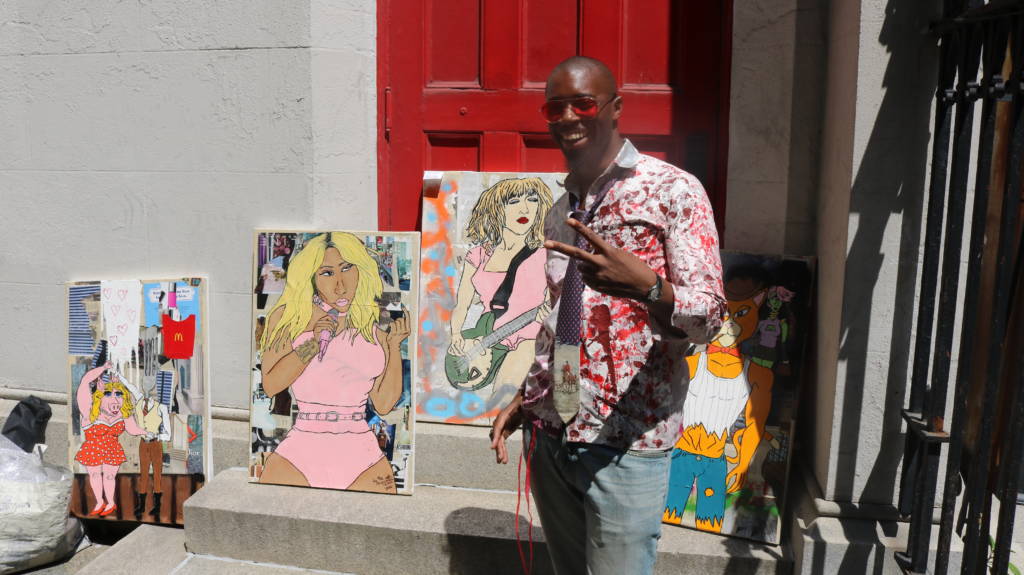It was Thanksgiving Day, 2013, and Dele Akerejah was alone.
He’d battled homelessness on and off since his sophomore year at Howard University, and the years of hard living and struggles with mental health had severed most of his personal relationships. A recent breakup with the woman he loved had been particularly tough, driving him to thoughts of suicide. Even within the comfort of his new government-subsidized apartment, he felt trapped. Isolated.
So Dele turned to the one constant in his life: art. He walked down the street to CVS and filled his bag with cardboard, magazines and glue. Back home, he lost himself in a flurry of scissors and paper snippets.
“The creation of art is medicinal,” Dele said. “It’s supposed to heal. Yes, we all need food, clothing and shelter, but you need to address the issues in your soul.”
***
Dele was 20 years old the first time he slept in a park. An altercation at Howard had gotten him kicked out of the dorms, and it took the better part to of a week to find a friend to stay with. He spent the intervening nights on a bench in D.C.’s Meridian Hill Park.
For Dele, who’d come from an affluent middle-class family, the experience was visceral and jarring. “Those nights were really rough,” he remembers. “We don’t recognize the luxury of these four walls and this roof a lot of times.”
Seven years later, after a food truck business went bust and left him unable to pay his rent, Dele was back on the streets. He got kicked out of a work-bed program, so he spent the entire summer in D.C.’s notorious Franklin Park. He cycled through various shelters and rehabilitation centers and, for a time, slept beside a fire station downtown. In 2011, after an incident that ended with Dele kicking out the window of a police car, he was arrested and sentenced to 30 days at St. Elizabeth’s Hospital, an inpatient psychiatric campus that once housed the would-be assassins of Andrew Jackson and Ronald Reagan.
[Read more: “It’s only after we’ve lost everything that we’re free to do anything.”]
It was here, trapped by white walls and mind-numbing routine, with his life and mental health drifting beyond his control, that Dele turned to art.
The supplies at a psych ward are limited, so he used whatever he could find — magazine cutouts, construction paper snippets, even apple juice lids — to tell elaborate stories through collage. The process was cathartic.
Art was more than an escape. It was a way for Dele to exert control over a world that was otherwise overwhelming him.

“It’s my way of building worlds that I feel safe in and can navigate,” he explains. “Being poor in America is such a powerless experience. It’s like how children whose parents are getting divorced have imaginary friends to establish some dimension of control in their lives. I experience that through art.”
Dele’s relationship with art began at a young age. He was five-years old when he sold his first drawing and he was 15 when he created his first oil painting. He and his cousin wrote and drew their own comic books at boarding school in Nigeria.
As Dele entered his late teens, however, a desire for “quick money” drove him away from the arts. He fell in with a revolving troupe of hustlers, drug dealers and con artists.
It was while sleeping in Franklin Park that he met a man named Hollis. The former Vietnam vet and retired Metro bus driver offered Dele something that had become rare during his time on the street: friendship.
Dele and Hollis spent the entire summer together in the park. It was rough going, but Dele can pick out moments of tranquility, like sipping beer out of paper-wrapped can while staring at the night sky and swapping stories with Hollis.
“W.E.B. Du Bois calls it the ‘kinship of the dispossessed,’” Dele said. “Once we all realize that we have nothing, we realize we have nothing to lose except for the love between us. That really got me through that period.”
Several years later, Dele stood beside the death bed of his good friend. Years of hard living and substance abuse had taken their toll. In the days leading up to the end, Dele recalls Hollis telling him that there was no more dopamine in his brain.
That may not have been an accurate medical diagnosis, but it was an inspiring moment for Dele, who resolved to spend his energy doing what made him truly happy. He wanted to create art.
“Human beings expressing themselves to one another and appreciating one another is the primary purpose of life after you get through Abraham Maslow’s ‘hierarchy of needs,’” Dele said. “You deal with food, clothing and shelter and all of the other stuff in between.
“But self-actualization comes through your art form.”





